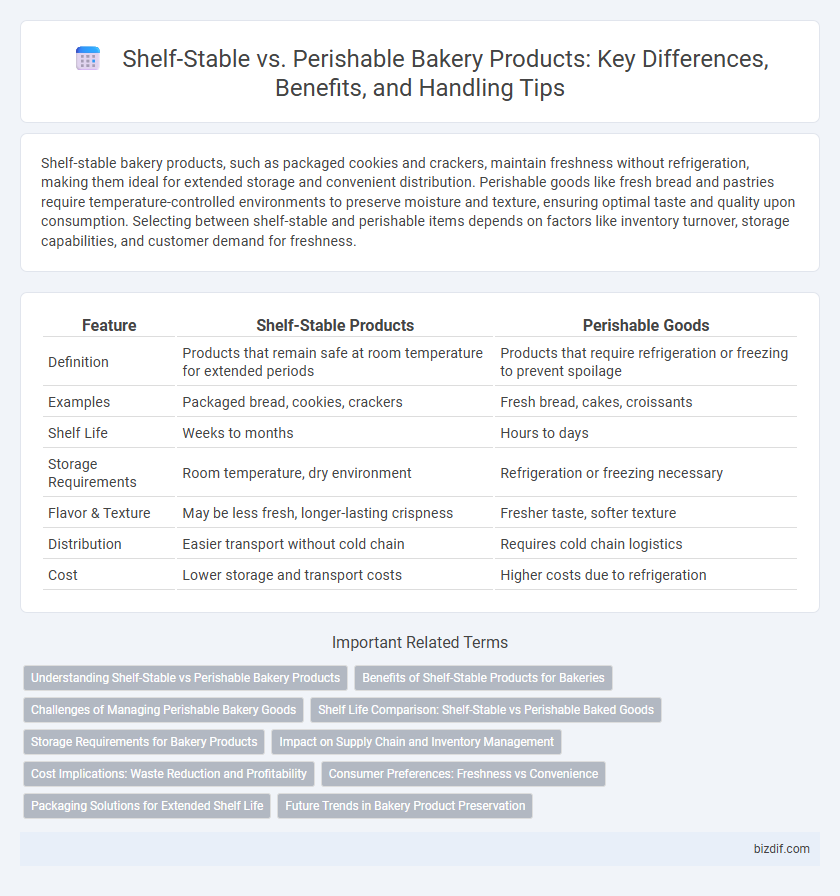Shelf-stable bakery products, such as packaged cookies and crackers, maintain freshness without refrigeration, making them ideal for extended storage and convenient distribution. Perishable goods like fresh bread and pastries require temperature-controlled environments to preserve moisture and texture, ensuring optimal taste and quality upon consumption. Selecting between shelf-stable and perishable items depends on factors like inventory turnover, storage capabilities, and customer demand for freshness.
Table of Comparison
| Feature | Shelf-Stable Products | Perishable Goods |
|---|---|---|
| Definition | Products that remain safe at room temperature for extended periods | Products that require refrigeration or freezing to prevent spoilage |
| Examples | Packaged bread, cookies, crackers | Fresh bread, cakes, croissants |
| Shelf Life | Weeks to months | Hours to days |
| Storage Requirements | Room temperature, dry environment | Refrigeration or freezing necessary |
| Flavor & Texture | May be less fresh, longer-lasting crispness | Fresher taste, softer texture |
| Distribution | Easier transport without cold chain | Requires cold chain logistics |
| Cost | Lower storage and transport costs | Higher costs due to refrigeration |
Understanding Shelf-Stable vs Perishable Bakery Products
Shelf-stable bakery products such as cookies, crackers, and breadsticks are designed to maintain freshness without refrigeration for extended periods, relying on low moisture and preservatives to inhibit microbial growth. Perishable bakery items like fresh bread, cakes, and pastries require refrigeration or rapid consumption due to higher moisture content and absence of preservatives, making them more susceptible to mold and spoilage. Understanding these differences is crucial for inventory management, shelf life optimization, and customer satisfaction in bakery operations.
Benefits of Shelf-Stable Products for Bakeries
Shelf-stable products offer bakeries extended shelf life without refrigeration, reducing storage costs and minimizing waste from spoilage. These ingredients ensure consistent quality and availability, supporting continuous production even during supply chain disruptions. Utilizing shelf-stable options enhances operational efficiency and profitability by enabling bulk purchasing and long-term inventory management.
Challenges of Managing Perishable Bakery Goods
Managing perishable bakery goods requires precise temperature control and strict inventory rotation to minimize spoilage and waste. Shelf-stable products, like packaged bread and cookies, pose fewer challenges since they have longer expiration dates and do not require refrigeration. The unpredictability of demand and short shelf life create significant logistical and financial challenges for bakeries dealing with fresh items.
Shelf Life Comparison: Shelf-Stable vs Perishable Baked Goods
Shelf-stable baked goods such as crackers, cookies, and certain bread varieties boast extended shelf life due to low moisture content and packaging innovations that inhibit microbial growth. In contrast, perishable baked goods like fresh bread, cakes, and pastries have a limited shelf life, typically lasting only 1-3 days at room temperature before spoilage risks increase. Proper storage conditions and preservatives can slightly extend perishables' freshness but cannot match the durability of shelf-stable products.
Storage Requirements for Bakery Products
Shelf-stable bakery products, such as packaged cookies and breadsticks, require storage in cool, dry environments to maintain freshness and prevent moisture absorption. Perishable bakery goods like fresh bread, cakes, and pastries demand refrigeration or controlled temperature settings between 2degC and 7degC to inhibit mold growth and preserve texture. Proper storage conditions directly impact product shelf life, quality, and food safety in bakery operations.
Impact on Supply Chain and Inventory Management
Shelf-stable bakery products like packaged bread and cookies simplify supply chain logistics by reducing the need for refrigeration and allowing longer storage periods, which minimizes waste and eases inventory management. Perishable goods such as fresh pastries and cakes require precise temperature control, expedited delivery, and frequent restocking to maintain product quality, increasing operational complexity. Effective supply chain strategies for bakeries must balance these factors to optimize inventory turnover while ensuring product freshness and customer satisfaction.
Cost Implications: Waste Reduction and Profitability
Shelf-stable bakery products significantly reduce waste due to their longer expiration periods, lowering costs associated with spoilage and inventory shrinkage. In contrast, perishable goods require faster turnover and precise demand forecasting to minimize loss, increasing labor and logistics expenses. Optimizing the balance between shelf-stable and perishable offerings enhances overall profitability by controlling waste and improving cash flow management.
Consumer Preferences: Freshness vs Convenience
Consumers often prioritize freshness in perishable bakery goods such as croissants and cakes, valuing texture and flavor that degrade quickly. Shelf-stable products like packaged bread and cookies attract buyers seeking convenience and longer storage without refrigeration. Balancing these preferences, bakeries tailor offerings to meet demands for either immediate consumption or extended shelf life.
Packaging Solutions for Extended Shelf Life
Shelf-stable bakery products require advanced packaging solutions such as vacuum sealing, modified atmosphere packaging (MAP), and moisture-resistant films to maintain freshness and extend shelf life. Perishable bakery goods benefit from packaging with breathable materials that regulate humidity and temperature control to prevent mold growth and staling. Incorporating oxygen absorbers and antimicrobial coatings in packaging also enhances product durability and reduces spoilage in both shelf-stable and perishable bakery items.
Future Trends in Bakery Product Preservation
Shelf-stable products in the bakery sector are increasingly enhanced by advanced packaging technologies such as modified atmosphere packaging and natural preservatives, extending freshness without refrigeration. Emerging trends highlight the use of bio-based coatings and edible films that inhibit microbial growth, aligning with consumer demand for clean-label and sustainable solutions. Innovations in ingredient formulation, including enzyme-based freshness enhancers, promise to revolutionize the shelf life of perishable goods while maintaining sensory quality and nutritional value.
Shelf-stable products vs Perishable goods Infographic

 bizdif.com
bizdif.com